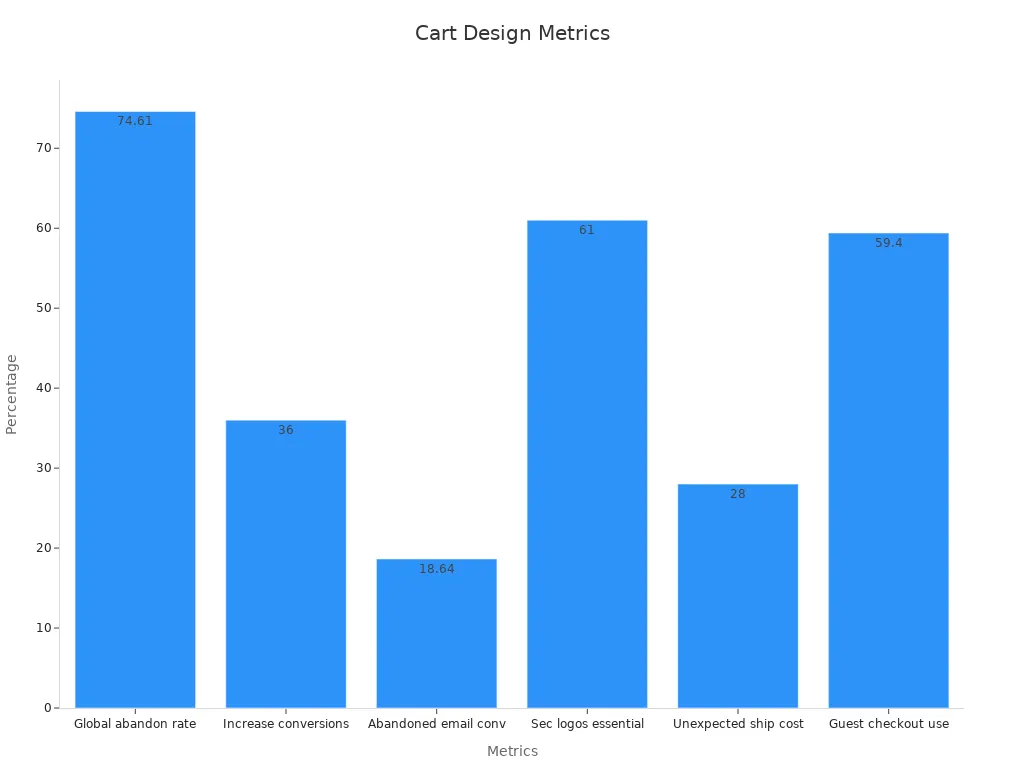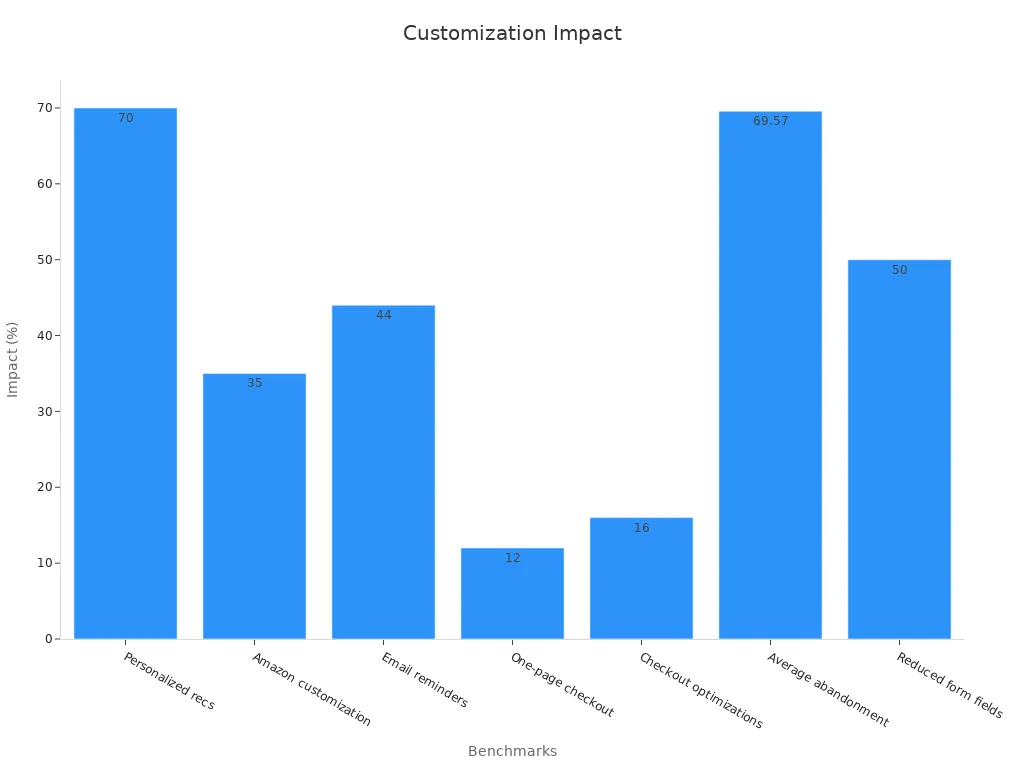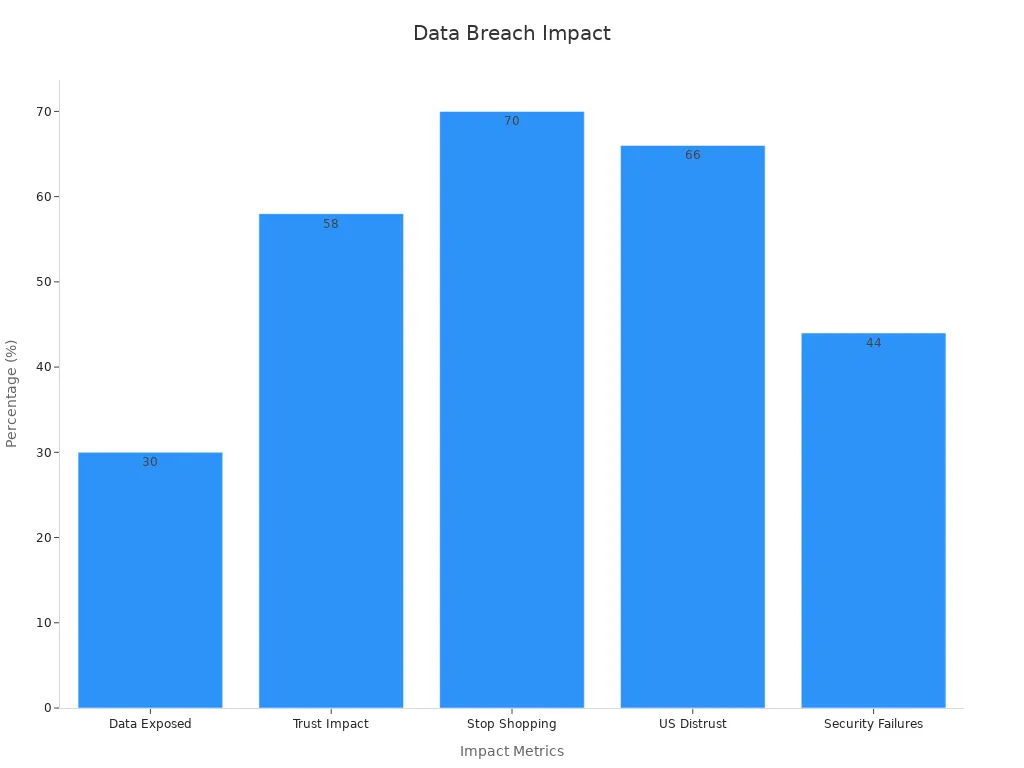Shopping Cart Websites: Features, Options, and Implementation Strategies for Online Businesses

The shopping cart acts as the engine of ecommerce, powering every transaction you make online. Shopping cart websites shape how you interact with an ecommerce platform and can determine the success of your business. When you use a shopping cart with strong features, you help create a seamless online shopping experience and improve customer experience.
A well-designed shopping cart reduces friction and builds trust, leading to better sales and happier customers.
Shopping cart websites play a vital role in ecommerce by lowering cart abandonment. Studies show the global cart abandonment rate is 74.61%, which means most shoppers leave before finishing their purchase. You can see this impact in the chart below:

You can also review the table below to understand how shopping cart design affects sales:
Metric / Factor | Numerical Evidence | Impact on Sales Conversion / User Behavior |
|---|---|---|
Global average cart abandonment rate | 74.61% | Indicates high loss of potential sales due to incomplete purchases |
Potential increase in conversions | 36% | Achievable by optimizing checkout experience |
Conversion rate from abandoned cart emails | 18.64% | Shows effectiveness of retargeting abandoned carts via email |
Consumers not completing purchase without security logos | 61% | Highlights importance of trust signals in checkout design |
Cart abandonment due to unexpected shipping costs | 28% | Points to need for transparent pricing in cart design |
Retailers offering guest checkout | 59.4% | Guest checkout reduces friction, improving conversion rates |
You face real challenges with ecommerce, but you can boost customer experience and drive sales by focusing on your shopping cart. Shopping cart websites that address issues like unexpected costs, account creation, and slow delivery help you retain more customers and build a thriving ecommerce platform.
The average shopping cart abandonment rate is about 70%.
Cart abandonment leads to $18 billion in lost revenue each year.
Sending follow-up emails for abandoned carts gets a 45% open rate and a 21% click-through rate.
Discounts on abandoned items lead 54% of shoppers to finish their purchase.
Extra costs, account creation, and slow delivery are top reasons for abandonment.
You can improve your ecommerce platform by making your shopping cart websites easy to use, trustworthy, and focused on customer experience.
Key Takeaways
A secure and easy-to-use shopping cart builds trust and helps customers complete purchases.
Offering multiple payment options and guest checkout reduces barriers and increases sales.
Personalized recommendations and product reviews boost customer engagement and confidence.
Choosing the right shopping cart platform depends on your budget, skills, and business needs.
Strong integration, mobile optimization, and cart recovery strategies lower abandonment and grow your business.
Key Features

A successful ecommerce business starts with a shopping cart that includes the right features. You need to focus on what helps your customers complete their purchases. The right features make the checkout process smooth, reduce cart abandonment, and boost conversions. Let’s look at the must-have features for your shopping cart.
Secure Checkout
Security is the foundation of trust in ecommerce. When you offer a secure checkout, you protect your customers’ information and give them confidence to finish their purchase. Many shoppers leave during the checkout process if they do not trust your site. In fact, 19% of users have abandoned a cart because they did not feel safe entering their credit card details. You can build trust by displaying security badges, SSL certificates, and well-known payment gateways. Multi-factor authentication also helps prevent fraud and keeps customer data safe. When you show these trust signals throughout the checkout, you lower cart abandonment and improve customer experience.
Tip: Always keep your website design up to date and display security logos near the payment section to reassure your customers.
Multiple Payment Options
You serve many types of customers in ecommerce, so you need to offer a variety of payment options. Some people prefer credit cards, while others use digital wallets like PayPal, Apple Pay, or Google Pay. If you only offer one or two payment methods, you risk losing sales. Studies show that nearly 6% of cart abandonment happens because shoppers cannot find their preferred payment options. By including more payment gateways and region-specific payment methods, you make the checkout process easier for everyone. This flexibility increases conversions and creates a better customer experience.
Offer credit cards, digital wallets, and buy now, pay later options.
Add region-specific payment gateways for international customers.
Make sure your payment options are easy to use on both desktop and mobile.
Personalized Recommendations
Personalized recommendations help you connect with your customers and improve their shopping experience. When you use data to suggest products based on past purchases or browsing habits, you make the shopping cart more relevant. This approach increases engagement and encourages repeat purchases. Research shows that personalized recommendations can boost marketing ROI by up to 30% and generate more than 30% of ecommerce revenue. Companies like Amazon see almost 35% of their sales come from these features. By tailoring the checkout process and shopping cart to each customer, you reduce cart abandonment and increase satisfaction.
Branded Cart Experience
A branded cart experience sets your ecommerce business apart. You want your shopping cart to match your brand’s look and feel, from colors to messaging. Consistency builds trust and keeps customers coming back. When you offer clear delivery windows, easy returns, and visible refund policies, you make the checkout process less stressful. Surveys show that 69% of shoppers prefer businesses that deliver a consistent experience. You can also use email and SMS to keep customers informed about their orders, which increases retention and reduces cart abandonment.
Use your brand colors and logo in the shopping cart.
Provide clear information about shipping, returns, and refunds.
Communicate with customers through their preferred channels.
Product Reviews
Product reviews give your customers confidence during the checkout process. When shoppers see positive feedback from others, they feel more comfortable completing their purchase. Reviews act as social proof and help reduce cart abandonment. Displaying testimonials and ratings near the shopping cart or checkout page increases trust and improves conversions. You can also use reviews to learn what your customers like or dislike, which helps you improve the overall customer experience.
Must-Have Shopping Cart Features Table
Feature | Benefit for Ecommerce | Impact on Cart Abandonment and Conversions |
|---|---|---|
One-page checkout | Faster checkout process | Reduces abandonment by simplifying steps |
Transparent fees | No surprise costs | Prevents drop-offs due to unexpected charges |
Mobile responsiveness | Easy shopping on any device | Increases conversions from mobile users |
No account needed | Removes barriers and speeds up checkout | |
Progress indicators | Shows checkout flow | Keeps customers engaged and informed |
Product thumbnails | Visual confirmation | Reduces mistakes and drop-offs |
Secure payment gateways | Safe transactions | Builds trust and lowers abandonment |
Personalized recommendations | Relevant product suggestions | Boosts engagement and repeat purchases |
Visible reviews and ratings | Social proof | Increases trust and conversions |
Note: Research by Baymard Institute shows that improving checkout design can increase conversion rates by over 35%. Simplifying the checkout process, offering guest checkout, and displaying all costs upfront are proven ways to reduce cart abandonment.
When you focus on these features, you create a shopping cart that supports your ecommerce goals. You improve the customer experience, reduce cart abandonment, and drive more conversions. Every feature you add should make the checkout process easier and more trustworthy for your customers.
Shopping Cart Websites Options
When you choose a shopping cart for your ecommerce platform, you face three main options. Each type fits different business needs and technical skills. Let’s look at hosted platforms, open-source solutions, and custom builds.
Hosted Platforms
Hosted platforms like Shopify and BigCommerce give you a ready-to-use ecommerce platform. You do not need to worry about hosting, security, or updates. The provider manages these tasks for you. You can set up your shopping cart quickly and start selling fast. Hosted platforms offer user-friendly interfaces and built-in shopping cart integration. You get 24/7 support and automatic updates. However, you pay a monthly fee, and you may find limits on customization. Advanced features or unique shopping cart integration often require extra apps or higher plans. Hosted platforms work well if you want a simple, reliable solution without much technical work.
Open-Source Solutions
Open-source shopping cart websites power over 70% of online stores. Platforms like WooCommerce, Magento, and PrestaShop give you full control over your ecommerce platform. You can access the source code and change your shopping cart as you wish. Open-source solutions let you add custom payment options and advanced shopping cart integration. You do not pay licensing fees, but you must handle hosting, security, and updates. You may need technical skills or developer help. Open-source shopping cart integration offers high flexibility and scalability for growing ecommerce businesses.
Custom Builds
Custom builds let you create a shopping cart that fits your exact needs. You or your developer can design every part of your ecommerce platform. Custom shopping cart integration gives you full control over features, payment methods, and user experience. You can scale your ecommerce platform as your business grows. Custom builds require more time, money, and technical resources. You must manage updates, security, and support. This option works best if you have unique requirements or want to stand out in the ecommerce market.
Aspect | Hosted Platforms | Open-Source Solutions | Custom Builds |
|---|---|---|---|
Customization | Limited | Extensive | Full |
Cost | Subscription fees | Hosting and support costs | Variable |
Maintenance | Provider-managed | User-managed | User-managed |
Ease of Use | Very easy | Moderate to complex | Depends on developer |
Support | 24/7 included | Community or paid | Developer or in-house |
Scalability | Plan-based | High with right setup | Fully scalable |
Features | Built-in and add-ons | Plugins and extensions | As required |
Tip: Choose a shopping cart option that matches your technical skills, budget, and business goals. The right shopping cart integration can help your ecommerce platform grow and succeed.
Implementation Strategies
Shopping Cart Integration
You need efficient shopping cart integration to connect your ecommerce platform with other systems. This step helps you manage orders, inventory, and customer data in real time. When you use best practices for seamless shopping cart integration, you reduce manual work and errors. You also improve the checkout process by linking your shopping cart to payment gateways, shipping tools, and marketing platforms. This approach increases conversion rates and customer satisfaction. You can track key metrics like conversion rates, average order value, and cart abandonment rates to measure success.
Metric | Result / Improvement |
|---|---|
Conversion Rate | |
Shopping Cart Volume | 8% increase |
Click-Through Rate | 8% increase |
Bounce Rate | Decreased |
Personalization Activation | Within 0.4 seconds, no downtime |
Customization
Customizing your shopping cart lets you match your brand and create a unique experience. You can use customizable checkout pages to add your logo, colors, and messaging. This step builds trust and keeps customers engaged. Personalized shopping features, such as recommendations and wish lists, help you increase cross-selling and repeat business. When you tailor the checkout process, you make it easier for shoppers to finish their purchase. Studies show that personalized product recommendations can boost purchase likelihood by 70%.

Cart Recovery
Many shoppers leave items in their carts. You can recover these sales by sending abandoned cart emails. A good cart recovery strategy uses a sequence of messages sent at the right times. For example, send the first email within one hour, the second after 24 hours, and the third after 72 hours with a discount or free shipping. These emails have high open and click-through rates and can increase average order value by 58%.
Metric / Insight | Statistic / Detail |
|---|---|
Open rate of recovery emails | 41.18% |
Conversion rate from recovery emails | 50% |
Average Order Value (AOV) increase | 58% higher than usual purchases |
Mobile Optimization
Most shoppers use mobile devices for ecommerce. You need to optimize your shopping cart for mobile users. Fast loading times, clear order summaries, and easy payment options help reduce friction. If your site loads in under one second, you can see 50% more mobile engagement. Slow sites and missing payment methods cause high abandonment rates. By tailoring the checkout process for mobile, you keep shoppers engaged and increase conversions.
Tip: Always test your mobile checkout process to find and fix problems quickly.
Efficient shopping cart integration, strong customization, smart cart recovery, and mobile optimization all work together. They help you reduce abandoned cart rates, improve security, and boost sales. When you focus on these strategies, you create a better ecommerce experience for your customers.
Security and Compliance
Protecting Customer Information
You must make protecting customer information your top priority when running an online store. Every time a shopper enters their details, they trust you to keep them safe. If you fail to provide strong security, you risk losing that trust forever. Nearly 70% of consumers say they would stop shopping with a brand after a data breach. About 66% of US shoppers would not trust a company again if their data was exposed. These numbers show how important security is for your business.

You handle sensitive data like credit card numbers and addresses. Hackers target shopping cart integration points because they know these are weak spots. You must use strong security practices to keep your store safe. Here are some best practices for shopping cart integration and security:
Enable multi-factor authentication at key access points.
Only use trusted third-party extensions and review internal APIs.
Separate your business and production environments.
Use secure communication protocols like SSH and avoid FTP.
Harden your operating systems by limiting access and patching often.
Restrict admin access to trusted IP addresses.
Review permissions regularly to prevent leaks.
Use Web Application Firewalls to block attacks.
Encrypt data at rest and in transit, and avoid storing unnecessary sensitive information.
Use strong password hashing with salting.
These steps help you achieve reduced security risks and keep your shopping cart integration safe. When you follow these rules, you show customers that you care about protecting customer information.
PCI Compliance
You must also meet PCI compliance standards if you accept credit card payments. PCI DSS rules protect payment data and help prevent fraud. In 2023, payment card fraud caused almost $34 billion in losses worldwide. PCI compliance helps you avoid these losses and builds trust with your shoppers. The PCI Security Standards Council requires over 300 security steps in 12 categories to keep cardholder data safe. Following these rules lowers your risk of data breaches, which can cost an average of $4.88 million per incident.
Statistic Description | Value / Insight |
|---|---|
Consumers who would stop shopping with a brand after a breach | 70% |
US consumers unwilling to trust breached companies with data | 66% |
Global e-commerce payment fraud losses (2022) | |
Projected global fraud losses (2023) | $48 billion |
PCI compliance penalty for non-compliance | $10,000+ per month |
PCI DSS 4.0 now requires stronger encryption and more use of multi-factor authentication. You must monitor your systems and review risks often. PCI compliance also means you use secure payment hardware and self-assessment tools. These steps make shopping cart integration safer for you and your customers. When you show you follow PCI rules, you build confidence and show that security is your top concern.
Tip: Regularly update your shopping cart integration and security settings to stay ahead of new threats.
Enhancing User Experience

Cart Page Design
You shape the customer experience with your shopping cart page. A clear and simple layout helps shoppers feel confident as they move toward checkout. You should show product images, names, sizes, colors, and prices. This information reduces doubt and keeps shoppers from leaving. Place the shopping cart icon in a visible spot, like the top right corner, so customers can track their items easily.
Personalized product recommendations can boost order value and improve customer experience. Suggest items based on browsing or purchase history, but avoid cluttering the page. Too many suggestions can distract shoppers and increase abandonment. Use star ratings on recommended products to build trust and help customers make quick decisions.
If a shopper’s cart is empty, use friendly messages and show popular products. This approach encourages more shopping and creates a positive customer experience. You can also let customers edit their cart easily. Allow them to change quantities or remove items without hassle. These features lower frustration and reduce cart abandonment.
Tip: Display security badges and offer help options like chat or email on the cart page. These steps build trust and support a smooth customer experience.
Conversion Optimization
You can increase your conversion rate by making the checkout process simple and fast. Avoid forcing shoppers to create an account before they buy. Forced registration leads to higher abandonment and hurts customer experience. Show all costs, including shipping and taxes, before checkout. Transparent pricing prevents surprises that cause cart abandonment.
Mobile responsiveness is key. Over 70% of shoppers use mobile devices, but poor mobile design leads to high abandonment. Use large buttons and easy-to-read forms to improve the customer experience on every device. Streamline checkout with one-page flows, progress bars, and autofill options. These changes reduce friction and help more shoppers finish their purchase.
Track metrics like cart abandonment rate, conversion rate, and click-through rate. Use A/B testing and heatmaps to see where shoppers drop off. Adjust your shopping cart design based on this data to improve customer experience and boost conversions. Studies show that better checkout design can reduce cart abandonment by 25% and raise your conversion rate.
You can grow your ecommerce business by choosing the right shopping cart features, platform, and strategies. A strong shopping cart helps you lower abandonment and boost sales. Key factors include free shipping, easy returns, and customer reviews. These influence shoppers and improve ecommerce results:
Free shipping drives 52.6% of purchases.
Coupons and discounts motivate 40.2% of shoppers.
Good user experience and simple checkout impact 28.7% of buyers.
Cart abandonment costs ecommerce $260 billion each year.
To improve your shopping cart and ecommerce success, follow these steps:
Make your shopping cart easy to use and secure.
Offer flexible payment and shipping options.
Show clear product details and reviews.
Use simple checkout and guest options.
Focus on security, smooth integration, and user experience. These steps help your ecommerce business grow and keep customers coming back.
FAQ
What is the most important feature in a shopping cart website?
You need a secure and easy checkout process. This helps your customers trust your store and finish their purchases. A simple checkout reduces confusion and keeps shoppers happy.
How can you reduce shopping cart abandonment?
Show all costs up front. Offer guest checkout. Send reminder emails for abandoned carts. These steps help you recover lost sales and improve your conversion rate.
Why does mobile optimization matter for shopping carts?
Most shoppers use phones or tablets. If your cart works well on mobile, you make shopping easier. Fast loading and big buttons help customers buy from you anywhere.
How do you keep customer data safe on your shopping cart website?
Always use SSL certificates and strong passwords. Update your software often. Limit who can access sensitive information. These actions protect your customers and build trust in your store.
See Also
Revolutionizing Online Store Operations With AI-Driven Solutions
Understanding Vending Machines: Advantages And Latest Innovations
Essential Insights Into Corner Stores And Their Importance
Cloudpick Technology Delivering Seamless Cashier-Free Shopping Experiences
Walgreens Self-Checkout Systems: Benefits And Retail Obstacles
